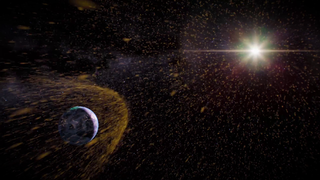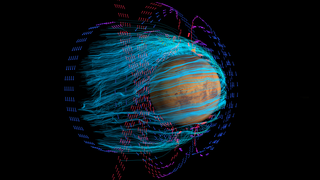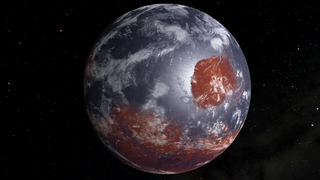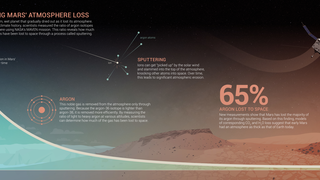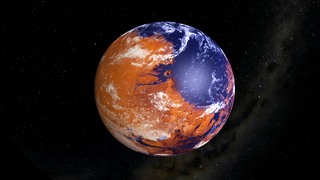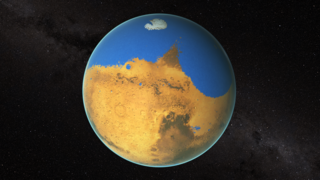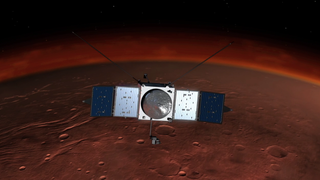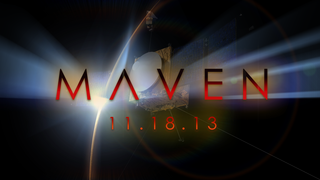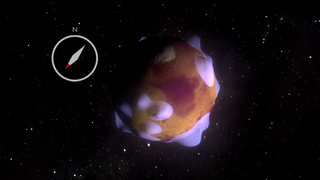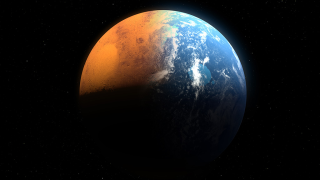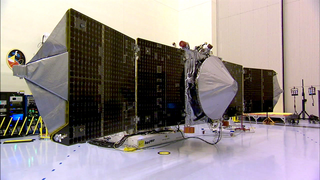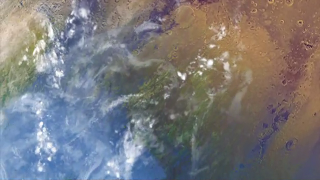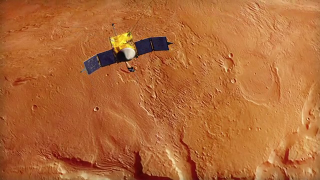Sun
Planets and Moons
ID: 11037
When you take a look at Mars, you probably wouldn't think that it looks like a nice place to live. It's dry, it's dusty, and there's practically no atmosphere. But some scientists think that Mars may have once looked like a much nicer place to live, with a thicker atmosphere, cloudy skies, and possibly even liquid water flowing over the surface. So how did Mars transform from a warm, wet world to a cold, barren desert? NASA's MAVEN spacecraft will give us a clearer idea of how Mars lost its atmosphere (and thus its water), and scientists think that several processes have had an impact.
MAVEN: Mars Atmospheric Loss
Learn more about these processes in the videos below!
Used Elsewhere In
Related
Credits
Chris Smith (HTSI): Lead Animator
Chris Smith (HTSI): Video Editor
Chris Smith (HTSI): Narrator
Dan Gallagher (USRA): Narrator
Chris Smith (HTSI): Producer
Bruce Jakosky (LASP): Scientist
Chris Smith (HTSI): Writer
Chris Smith (HTSI): Video Editor
Chris Smith (HTSI): Narrator
Dan Gallagher (USRA): Narrator
Chris Smith (HTSI): Producer
Bruce Jakosky (LASP): Scientist
Chris Smith (HTSI): Writer
Please give credit for this item to:
NASA/Goddard Space Flight Center
NASA/Goddard Space Flight Center
Short URL to share this page:
https://svs.gsfc.nasa.gov/11037
Mission:
MAVEN: Mars Atmosphere and Volatile EvolutioN
This item is part of these series:
Narrated Movies
MAVEN Science Videos
MAVEN
Goddard TV Tape:
G2012-098 -- MAVEN: Mars Atmospheric Loss Processes
Keywords:
SVS >> HDTV
SVS >> Mars
SVS >> Music
SVS >> Satellite
SVS >> Solar Wind
GCMD >> Earth Science >> Atmosphere
GCMD >> Earth Science >> Sun-earth Interactions >> Solar Activity >> Solar Ultraviolet
SVS >> SDO
SVS >> Edited Feature
SVS >> Heliophysics
SVS >> MAVEN
DLESE >> Narrated
SVS >> Corona
NASA Science >> Sun
NASA Science >> Planets and Moons
GCMD keywords can be found on the Internet with the following citation: Olsen, L.M., G. Major, K. Shein, J. Scialdone, S. Ritz, T. Stevens, M. Morahan, A. Aleman, R. Vogel, S. Leicester, H. Weir, M. Meaux, S. Grebas, C.Solomon, M. Holland, T. Northcutt, R. A. Restrepo, R. Bilodeau, 2013. NASA/Global Change Master Directory (GCMD) Earth Science Keywords. Version 8.0.0.0.0
https://svs.gsfc.nasa.gov/11037
Mission:
MAVEN: Mars Atmosphere and Volatile EvolutioN
This item is part of these series:
Narrated Movies
MAVEN Science Videos
MAVEN
Goddard TV Tape:
G2012-098 -- MAVEN: Mars Atmospheric Loss Processes
Keywords:
SVS >> HDTV
SVS >> Mars
SVS >> Music
SVS >> Satellite
SVS >> Solar Wind
GCMD >> Earth Science >> Atmosphere
GCMD >> Earth Science >> Sun-earth Interactions >> Solar Activity >> Solar Ultraviolet
SVS >> SDO
SVS >> Edited Feature
SVS >> Heliophysics
SVS >> MAVEN
DLESE >> Narrated
SVS >> Corona
NASA Science >> Sun
NASA Science >> Planets and Moons
GCMD keywords can be found on the Internet with the following citation: Olsen, L.M., G. Major, K. Shein, J. Scialdone, S. Ritz, T. Stevens, M. Morahan, A. Aleman, R. Vogel, S. Leicester, H. Weir, M. Meaux, S. Grebas, C.Solomon, M. Holland, T. Northcutt, R. A. Restrepo, R. Bilodeau, 2013. NASA/Global Change Master Directory (GCMD) Earth Science Keywords. Version 8.0.0.0.0
